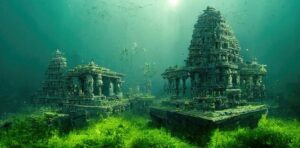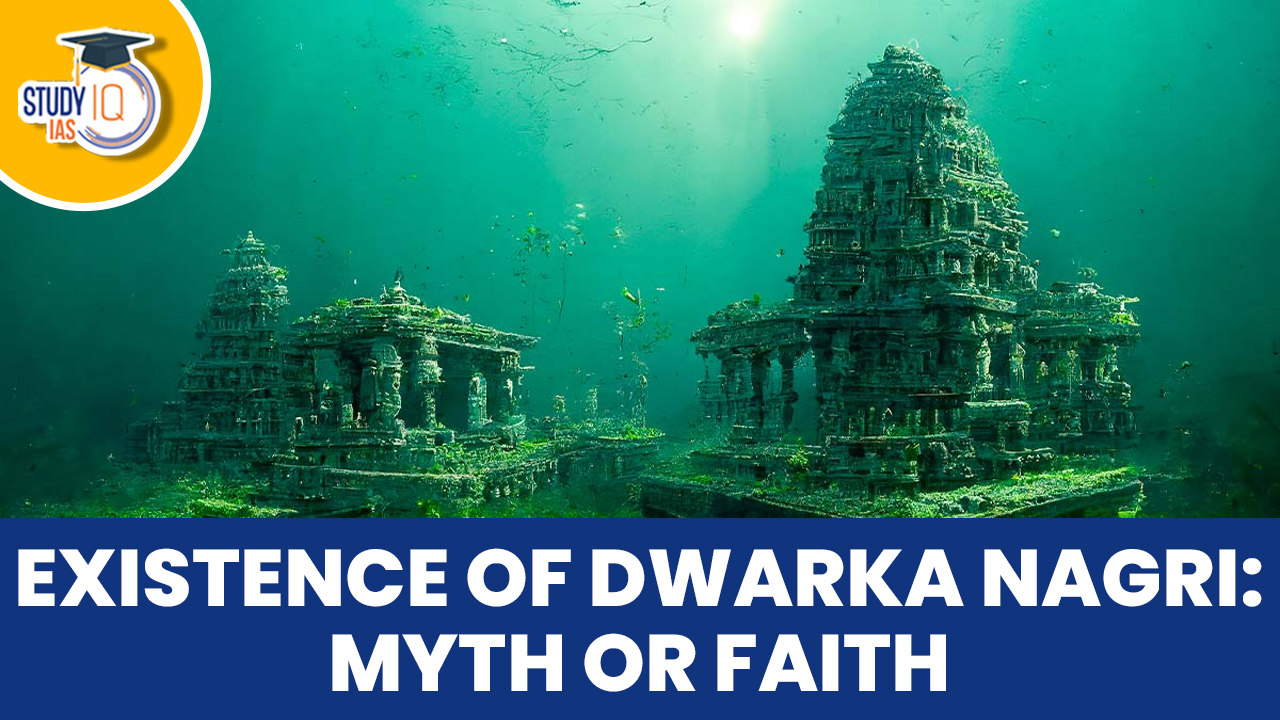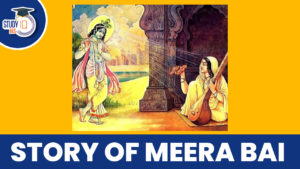Table of Contents
Existence of Dwarka Nagri: Myth or Faith- The existence of the ancient city of Dwarka, as described in Hindu mythology and texts, is a matter of faith and legend, and it is also a subject of historical and archaeological interest.
Existence of Dwarka Nagri: History
The ancient Mahabharata epic contains the most well-known account regarding the disappeared city of Dwarka. Like Atlantis, Dwarka is believed to have submerged at some point in the distant past. But unlike Atlantis, whose ruins have never been unearthed, this ancient kingdom’s remains might be found in the depths.
The city of Dwaraka was created in response to Jarasandha, the emperor of Magadha, who was frequently assaulting Mathura, according to the holy text of Srimad Bhagavatam. Lord Krishna made the decision to create a new city on India’s western shore in order to stop additional assaults on his clan. This idea came to life thanks to the renowned architect Vishwakarma. Ancient texts claim that Krishna constructed Dwarka close to Kushasthali. The city, which was home to people in over 900 palaces, swiftly gained notoriety and turned into the main hub of Lord Krishna’s mission. The only way to get to the strongly defended city was via ship. The mysterious lost city of Dwarka immediately gained attention and stirred wonderment all around the world.
The city was flooded and submerged by the Arabian Sea on the same day when Krishna left the Earth to join the spiritual world after 125 years, and this is when the Kali age began, according to the 23rd and 34th stanzas of the Mahabharata. The god of the sea regained the area, drowning the lost city of Dwarka but sparing the palace of Lord Krishna. Additionally, it is claimed that a flying contraption named Vimana attacked the vanished city of Dwarka.
Ancient extraterrestrial hypotheses are intrigued by the depiction of the battle because it seems to imply that it was fought using cutting-edge technology and potent weaponry, potentially even from orbit. The spacecraft launched an attack on the city using energy weaponry, which resembled a lightning strike to onlookers, and it was so devastating that much of the city lay in ruins following the attack.
Archaeological Findings of Dwarka Nagri
One theory holds that the lost city of Dwarka was constructed on reclaimed land about 3500 years ago and drowned when sea levels rose. Scientific research has shown that the area’s sea level has fluctuated significantly until reaching its current levels in 1000 CE. There are a variety of potential causes for these shifting sea levels, including geological disturbances and coastal erosion.
An abundance of anchors were found here, proving that Dwarka was a historic port and must have participated in trade between Indian and Arabic regions from the 15th to the 18th century. The harbour area was also historically used as a place for vessel anchoring. The Sanskrit term “Dwarka” literally translates to “portal” or “door,” suggesting that this ancient port city may have acted as a gateway for foreign navigators entering India. Now, archaeologists are preparing an underwater excavation to look for the remains of the ancient city walls.
Dwarka Nagri Underwater Location
The city’s ancient incarnation, referred to in the epic Mahabharata as the ancient kingdom of Krishna, was spread across almost 84km as a fortified city where the Gomti River and the Arabian Sea meet. According to the text, the ancient city was sunk beneath the Arabian Sea upon Krishna’s death.

Existence of Dwarka Nagri: Myth or Faith
Hinduism accords a great deal of religious significance to the mythical and mythological significance of the city of Dwarka. It is thought that during his earthly life, Lord Krishna’s kingdom’s capital was located there. The Mahabharata, the Puranas, and other Hindu scriptures all make reference to Dwarka and characterise it as a flourishing and heavenly city.
Historical and Archaeological Evidence
Off the coast of Dwarka, primarily in the modern Indian state of Gujarat, there have been archaeological excavations and underwater surveys. These searches have uncovered underwater buildings and artefacts that some archaeologists and experts think might be connected to an ancient metropolis. These discoveries have raised questions and discussions regarding whether a historical Dwarka existed.
Research and Debate Still Underway
There is still more to learn about the submerged remnants’ age, identity, and relationship to the fabled Dwarka mentioned in Hindu texts. While some scholars think that these discoveries might be connected to an old city, others are hesitant and looking for further proof to draw a firm conclusion.
Faith & Belief
Dwarka is a sacred and spiritually significant location for millions of Hindus, not just a historical or archaeological site. It is recognised as a place of adoration and pilgrimage and symbolises the residence of Lord Krishna. The Dwarkadhish Temple in Dwarka is frequented by pilgrims looking to connect with Lord Krishna and get blessings.
Dwarka Nagri of Lord Krishna
History and Mythology
After leaving Mathura, Lord Krishna founded the city of Dwarka on India’s western coast, according to Hindu writings, particularly the Mahabharata and the Puranas. During his rule, it served as both his capital and a thriving kingdom.
One of Dwarka’s most well-known and beloved temples is the Dwarkadhish Temple, often referred to as the Jagat Mandir. It is dedicated to Lord Krishna and is thought to be located where his former palace once stood. Hindus go great distances to visit the temple, which draws followers from all around the world.
Dwarka Submerged
Off the coast of Dwarka, archaeological digs and underwater surveys have uncovered sunken buildings and artefacts. Some academics and archaeologists think that these discoveries might be connected to the historic Dwarka that is mentioned in Hindu texts. Regarding the timing and veracity of these discoveries, there is, nonetheless, ongoing inquiry and discussion.
The Hindus have a great deal of religious significance for the city of Dwarka. It is linked to a number of tales and incidents from Lord Krishna’s life, such as his early years, his union with Queen Rukmini, and his participation in the Mahabharata. Devotees travel to Dwarka to experience the city’s spiritual energy, perform religious rituals, and ask for favours.
Destination for Pilgrimage
For devotees of Lord Krishna and Hinduism in general, Dwarka is a significant pilgrimage site. The city is one of the four pilgrimage sites that make up the Char Dham Yatra, along with Badrinath, Puri, and Rameswaram. Visitors to Dwarka come to pray, take part in religious rituals, and become completely engrossed in their devotion to Lord Krishna.


 Story of Meera Bai and Her Devotion For ...
Story of Meera Bai and Her Devotion For ...
 Desert Climate, Distribution, Climatic C...
Desert Climate, Distribution, Climatic C...
 Deserts of India Map, Features of Thar D...
Deserts of India Map, Features of Thar D...





















